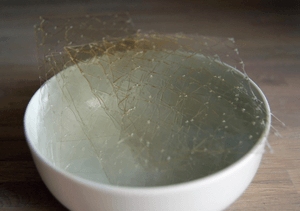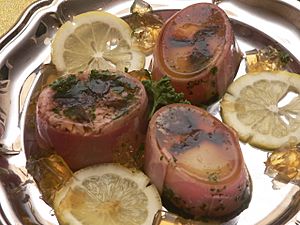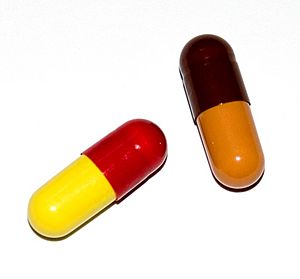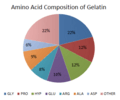Gelatin facts for kids
Gelatin is a special kind of protein. It comes from something called collagen. Collagen is a natural protein. You can find it in the tendons, ligaments, and tissues of mammals. Think of it like the glue that holds parts of an animal's body together.
To make gelatin, people boil animal parts. These include connective tissues, bones, and skins. Most often, it comes from cows and pigs. When boiled, the collagen turns into a jelly as it cools.
Gelatin is used in many ways. As a food, it helps make desserts like jelly. It can also help preserve fruit and meat. You might find it in powdered milk too. Beyond food, gelatin can be used as a type of glue. It's also found in some medicines as a syrup. Gelatin is a liquid when warm. But it becomes a solid jelly when it cools down.
Contents
What Gelatin Is Used For
Gelatin in Food History
People have used gelatin in food for a very long time. The first known use was in Medieval Britain around the 1400s. Back then, people boiled cattle hooves to make a gel.
Later, in 1754, a British company got a patent to make gelatin. It became very popular in the USA and France in the 1800s. This is when famous products like Jell-O started. In the late 1800s, Charles and Rose Knox in New York made and sold gelatin powder. This made gelatin even more popular for cooking.
Cooking with Gelatin
Gelatin is best known for making foods jiggly! It's a gelling agent in cooking. You can find different kinds of gelatin in many foods.
Some common foods with gelatin are gelatin desserts and trifles. It's also in marshmallows and candy corn. Many candies like Peeps, gummy bears, fruit snacks, and jelly babies use gelatin.
Gelatin can also be a stabilizer. This means it helps keep foods from separating. It can also make foods thicker or give them a certain texture. Foods like yogurt, cream cheese, and margarine use it. In low-fat foods, gelatin can make them feel like they have more fat.
In some Chinese soup dumplings, like xiaolongbao, gelatin is key. The filling has ground pork and gelatin cubes. When the dumplings cook, the gelatin melts. This creates a soupy inside with a special sticky texture.
Gelatin is also used to make juices clear. For example, it helps clarify apple juice and vinegar. A special type of gelatin called Isinglass comes from fish. It is still used to make wine and beer clear.
Other Uses for Gelatin
Gelatin has many uses outside of food:
- Color Gels: In theaters, lights use "color gels" to change the light's color. These were historically made from gelatin.
- Medicine Capsules: Most medicine capsules are made of gelatin. This makes them easier to swallow. There are plant-based options, but they cost more.
- Glues: Some animal glues, like hide glue, are a type of unrefined gelatin.
- Photography: Gelatin holds tiny silver halide crystals in photographic films. It's also used in photographic papers. No other material has been found that works as well and costs as little.
- Carriers: Gelatin can carry other substances. For example, it makes β-carotene mix with water. This gives a yellow color to drinks with β-carotene.
- Binders: Gelatin helps bind things together. It's used in match heads and sandpaper.
- Cosmetics: Some beauty products use a form of gelatin called hydrolyzed collagen. It doesn't form a gel.
- Paper: Gelatin was used to make paper stronger and less absorbent for centuries. Today, it's still found in watercolor paper and some art papers. It also helps keep the wrinkles in crêpe paper.
Images for kids
-
Amino acid composition
See also
 In Spanish: Gelatina para niños
In Spanish: Gelatina para niños





